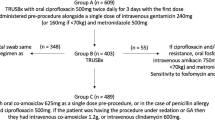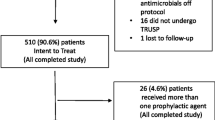Abstract
Purpose
Despite the recent innovations, complications of prostate biopsy can occur. The aim of this study was a prospective monitoring of major septic complications occurring after transrectal prostate biopsy, to describe their causing agents, to report the clinical course of these patients, and to give guidelines based on our personal experience.
Methods
This prospective study was carried out between January 2009 and September 2010. Complications were evaluated by telephone interviews.
Results
Between January 2009 and September 2010, 447 (96.5%) completed the telephone interview. Urosepsis occurred in ten patients (2.2%) and in three cases evolved into septic shock. Of these ten patients, nine had a positive blood culture, of whom eight for Escherichia coli and one for Aeromonas hydrophila, Aeromonas caviae, and Aeromonas sobria. In seven cases, the E. coli isolated were resistant to fluoroquinolone and six produced an extended spectrum beta-lactamase. Six E. coli were classified as multidrug-resistant organisms. Of the 10 patients, one died after the onset of multiorgan failure. For the other nine, the mean time spent in the hospital was 9 days (range, 6–15 days).
Conclusions
Escherichia coli are developing new drug resistances. Early recognition of patients who harbor MDRO E. coli in their rectum or in the urine could be an important strategy for preventing sepsis. If a patient who has recently undergone transrectal prostate biopsy shows clinical signs of sepsis in the 48 h, a multiresistant E. coli infection must be suspected. The patient must be admitted urgently to the hospital, and carbapenem antibiotic therapy should be started.
Similar content being viewed by others
References
Farwell WR, Linder JA, Jha AK (2007) Trends in prostate-specific antigen testing from 1995 through 2004. Arch Intern Med 167:2497–2502
Welch HG, Albertsen PC (2009) Prostate cancer diagnosis and treatment after the introduction of prostate-specific antigen screening. JNCI 101:1–5
Young JL, Liss MA, Szabo RJ (2009) Sepsis due to fluoroquinolone-resistant Escherichia coli after transrectal ultrasound-guided prostate needle biopsy. Urology 74:332–338
Heidenreich A, Aus G, Bolla M et al (2008) EAU guidelines on prostate cancer. Eur Urol 53:68–80
Gore JL, Shariat SF, Miles BJ et al (2001) Optimal combinations of systematic sextant and laterally directed biopsies for the detection of prostate cancer. J Urol 165:1554–1559
Miura T, Tanaka K, Shigemura K, Nakano Y, Takenaka A, Fujisawa M (2008) Levofloxacin resistant Escherichia coli sepsis following an ultrasound-guided transrectal prostate biopsy: report of four cases and review of the literature. Int J Urol 15:457–459
Ekici S, Cengiz M, Turan G, Alış EE (2012) Fluoroquinolone-resistant acute prostatitis requiring hospitalization after transrectal prostate biopsy: effect of previous fluoroquinolone use as prophylaxis or long-term treatment. Int Urol Nephrol 44:19–27
Chiang IN, Chang SJ, Pu YS, Huang KH, Yu HJ, Huang CY (2007) Major complications and associated risk factors of transrectal ultrasound guided prostate needle biopsy: a retrospective study of 1875 cases in Taiwan. J Formos Med Assoc 106:929–934
de Jesus CM, Corrêa LA, Padovani CR (2006) Complications and risk factors in transrectal ultrasound-guided prostate biopsies. Sao Paulo Med J 124:198–202
Kakehi Y, Naito S (2008) Complication rates of ultrasound-guided prostate biopsy: a nation-wide survey in Japan. Int J Urol 15:319–321
Ecke TH, Gunia S, Bartel P, Hallmann S, Koch S, Ruttloff J (2008) Complications and risk factors of transrectal ultrasound guided needle biopsies of the prostate evaluated by questionnaire. Urol Oncol 26:474–478
Raaijmakers R, Kirkels WJ, Roobol MJ, Wildhagen MF, Schrder FH (2002) Complication rates and risk factors of 5802 transrectal ultrasound-guided sextant biopsies of the prostate within a population-based screening program. Urology 60:826–830
Shandera KC, Thibault GP, Deshon GE Jr (1998) Variability in patient preparation for prostate biopsy among American urologists. Urology 52:644–646
Kapoor DA, Klimberg IW, Malek GH et al (1998) Single-dose oral ciprofloxacin versus placebo for prophylaxis during transrectal prostate biopsy. Urology 52:552–558
Argyropoulos AN, Doumas K, Farmakis A et al (2007) Time of administration of a single dose of oral levofloxacin and its effect in infectious complications from transrectal prostate biopsy. Int Urol Nephrol 39:897–903
Johnson L, Sabel A, Burman WJ et al (2008) Emergence of fluoroquinolone resistance in outpatient urinary Escherichia coli isolates. Am J Med 121:876–884
Kronvall G (2010) Antimicrobial resistance 1979–2009 at Karolinska hospital, Sweden: normalized resistance interpretation during a 30-year follow-up on Staphylococcus aureus and Escherichia coli resistance development. APMIS 118:621–639
Hopkins KL, Davies RH, Threlfall EJ (2005) Mechanisms of quinolone resistance in Escherichia coli and Salmonella: recent developments. Int J Antimicrob Agents 25:358–373
Ena J, Amador C, Martinez C, Ortiz de la Tabla V (1995) Risk factors for acquisition of urinary tract infections caused by ciprofloxacin resistant Escherichia coli. J Urol 153:117–120
Tang P, Xie KJ, Wang B, Deng XR, Ou RB (2010) Antibacterial therapy improves the effectiveness of prostate cancer detection using prostate-specific antigen in patients with asymptomatic prostatitis. Int Urol Nephrol 42:13–18
Pitout JD, Laupland KB (2008) Extended-spectrum beta-lactamaseproducing Enterobacteriaceae: an emerging public-health concern. Lancet Infect Dis 8:159–166
Hadway P, Barrett LK, Waghorn DJ et al (2009) Urosepsis and bacteraemia caused by antibiotic-resistant organisms after transrectal ultrasonography-guided prostate biopsy. BJU Int 104:1556–1558
Lange D, Zappavigna C, Hamidizadeh R, Goldenberg SL, Paterson RF, Chew BH (2009) Bacterial sepsis after prostate biopsy—a new perspective. Urology 74:1200–1205
Horcajada JP, Busto M, Grau S et al (2009) High prevalence of extended-spectrum beta-lactamase-producing enterobacteriaceae in bacteremia after transrectal ultrasound-guided prostate biopsy: a need for changing preventive protocol. Urology 74:1195–1199
Calbo E, Romani V, Xercavins M et al (2006) Risk factors for community-onset urinary tract infections due to Escherichia coli harbouring extended-spectrum betalactamases. J Antimicrob Chemother 57:780–783
Ortega M, Marco F, Soriano A et al (2009) Analysis of 4758 Escherichia coli bacteraemia episodes: predictive factors for isolation of an antibiotic-resistant strain and their impact on the outcome. J Antimicrob Chemother 63:568–574
Azap OK, Arslan H, Serefhanoglu K et al (2010) Risk factors for extended-spectrum betalactamase positivity in uropathogenic Escherichia coli isolated from community-acquired urinary tract infections. Clin Microbiol Infect 16:147–151
Conflict of interest
All authors disclose any financial and personal relationships with other people or organisations that could inappropriately influence (bias) their work. There is no actual or potential conflict of interest in relation to this article.
Author information
Authors and Affiliations
Corresponding author
Rights and permissions
About this article
Cite this article
Carmignani, L., Picozzi, S., Spinelli, M. et al. Bacterial sepsis following prostatic biopsy. Int Urol Nephrol 44, 1055–1063 (2012). https://doi.org/10.1007/s11255-012-0145-9
Received:
Accepted:
Published:
Issue Date:
DOI: https://doi.org/10.1007/s11255-012-0145-9




